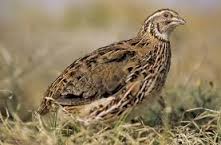The European quail (Coturnix coturnix) is a bird from the family of pheasants with a short tail and relatively large wings. He is slightly smaller than a starling: 16-18 cm, with a wingspan of 32-35 cm and a weight of 100 to 150 grams. He is earth -colored and brown striped with a white eye stripe.
 It is the only bird migratory game fowl (Galliformes). It hibernates in the Mediterranean. The European quail occurs from Scandinavia to the whole of Africa, and from the British Isles to Central Asia.
It is the only bird migratory game fowl (Galliformes). It hibernates in the Mediterranean. The European quail occurs from Scandinavia to the whole of Africa, and from the British Isles to Central Asia.
The quail migrates from April to May and from late August to October. in Belgium and the Netherlands, he has become rare and protected.
He flies with shallow, rapid wing beats just above the ground. Out of migration he flies low and clumsy. If he is caught, he will rather play quietly death pressed against the ground than run away.
The bird feeds on all that can be found on the ground: insects, greens and seeds.
The quail likes open areas with low vegetation, grass and hay and agricultural areas.
The hen make them in a sheltered spot a rough hole in the ground. Between mid-May and June 7 to 14 light gray with dark beige specks - eggs are placed in the ground litter. Only she incubates them 17 days. She carries the chicks alone. They can fly after two days. They are adult after more than 12 weeks of age.
Quail are grown industrially for fattening and laying hens, respectively for the meat and the 11 -ounce speckled egg.
‘Birdwatchers‘ keep quail to pick spilled seed on the bottom of the aviary. A couple can live all of the spilled seed.
The Romans ate all kind of birds. Brains and tongues of parrots and others species were a decadent delicacy. Nightingales were for their singing so valued they were more expensive than a slave. The most expensive nightingale cost 600,000 sesterces, the value of 200 slaves. (The value of a slave would be comparable to that of a car nowadays.) But in order to surpass another perversly nightingales were also eaten.
